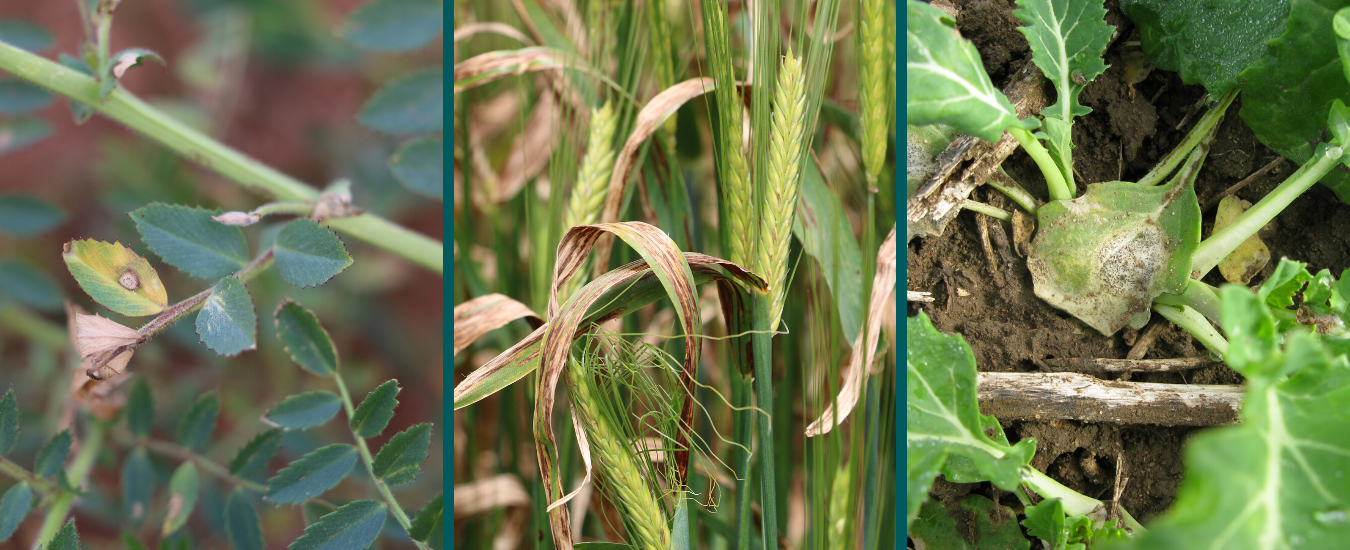The following papers were presented at the GRDC Updates in Bendigo in February 2020. This article includes a summary of key points from each paper, click on the title to find the full text.
Cereal Disease Update 2020
Authors: Grant Hollaway and Mark McLean (Agriculture Victoria, Horsham), Hugh Wallwork (South Australian Research and Development Institute (SARDI), Adelaide), Art Diggle (Department of Primary Industries and Regional Development (DPIRD), Perth), Fran Lopez Ruiz (Centre for Crop and Disease Management, Curtin University, Bentley, WA) and Robert Park (The University of Sydney).
- The proactive use of different management options in combination (such as variety selection, paddock selection, and appropriate fungicide use), provides proven sustainable and economic control for both root and foliar diseases.
- A new strain of stripe rust is important to durum wheat and some bread wheats with new ratings published in the 2020 Victorian Disease Guide.
- A new decision-support tablet-based app will help in the management of stripe rust.
- Recent reports of fungicide resistance in cereal pathogens highlight the importance of avoiding fungicide use that increases the likelihood of resistance development.
The health report – 2019 pulse disease seasonal update and NVT disease ratings
Authors: Joshua Fanning, Jason Brand Tim Nigussse, Winnie Liu Heang, Mitch Fromm, and Grant Hollaway (Agriculture Victoria, Horsham), Sara Blake, and Jenny Davidson (South Australian Research and Development Institute (SARDI)).
- Consult a current pulse disease guide for the latest pulse disease ratings and up to date disease management information.
- A new national pulse disease rating system has been implemented, which will ensure a consistent and independent disease rating system for pulses.
- In lentils, there are now two pathotypes of Ascochyta blight (AB) present in the southern region. In Victoria, the AB rating for PBA Hurricane XT has not been downgraded, as it has in South Australia (SA). Growers are advised to closely monitor both PBA Hurricane XT and PBA Hallmark XT varieties for infection, and manage as a potentially higher risk of AB.
- In faba beans, there are currently two pathotypes of AB which are widespread across the southern region. It is assumed reports of higher incidences of AB on PBA Samira is due to on-farm retained seed which had outcrossed with more susceptible varieties. Ensure seed is isolated from other varieties by a minimum of 200m to minimise the risk of cross-pollination.
- Following the first signs of AB infection in chickpea, a fungicide application of a premium product has resulted in grain yield and AB infection comparable to the multiple preventative application of fungicides. Research is continuing to ensure a similar result is observed across seasons.
Blackleg – new seed treatment, stubble management and fungicide resistance
Author: Steve Marcroft (Marcroft Grains Pathology, Horsham, Vic), Angela van de Wouw (School of BioSciences, University of Melbourne, Vic) and Susie Sprague (CSIRO Agriculture & Food, Canberra, ACT).
- Blackleg crown canker results from infection during early seedling growth. Prior to sowing, use the BlacklegCM decision support tool to identify high-risk paddocks and explore management strategies to reduce yield loss.
- New succinate dehydrogenase inhibitor (SDHI) seed treatment fungicides have higher efficacy, increased longevity, and improved seed safety.
- The improved efficacy of SDHI fungicide may result in a reduced need for early foliar application of fungicide (4-10 leaf applications).
- Modern farming systems that enable earlier sowing/germination may result in reduced damage from blackleg crown cankers.
- Blackleg pathogen populations with resistance to the triazole fungicides fluquinconazole, flutriafol, and a tebuconazole + prothioconazole mixture have been detected. No resistance has been detected for new SDHI and quinine-outside inhibitor (QoI) chemistries.
- Blackleg upper canopy infection (UCI) is the collective term for flower, peduncle, pod, main stem, and branch infection, but does not include crown canker.
- UCI can cause yield losses of up to 30%. Yield loss is reduced by selecting cultivars with effective major gene resistance and using crop management strategies to delay the commencement of flowering to later in the growing season, especially in high disease risk areas.
- Fungicide applications at 30% bloom often controls UCI but does not always result in yield gains. 30% bloom fungicide application is unlikely to control pod infection.
The top five exotic nasties to have on your watch list
Authors: Jemma Pearl, Luise Fanning and Dale Grey
- Khapra beetle, Karnal bunt, Wheat stem rust pathogen Ug99, Lupin anthracnose, and Barley stem gall midge are all exotics that are risks to the Victorian grain industry.
- Thirty-four key exotic pests, diseases, and parasitic weeds can be found in the 2020 edition of CropSafe guide: Victorian guide to exotic pests and diseases of grain crops.



